Chan Kam Pong is a lawyer living in Hong Kong. He has been an avid collector of Puerh tea for more than ten years. His personal experiences have benefited many readers of our Chinese magazines. He has published numerous articles and an English book, "First Step to Chinese Puerh Tea. " If anyone knows how a collector should store their Puerh collection it is Mr. Chan.
In Part 1 of this series we talked about the conditions necessary for storing Puerh tea at home, and the steps a tea cake should go through prior to storage. Continuing from the previous article, I thought we would here discuss how we handle the storage of our Puerh tea cakes over time, delving deeper into an understanding of what makes a good storage environment. Where we should keep our precious Puerh in the coining decades so as to maximize fermentation, and what factors of storage need to be monitored over the duration of that time are both important questions that collectors need answered. In my personal experience, there are two aspects of Puerh storage that one needs to pay the most attention to: The first, and most important, is to reduce and minimize any risks during storage. And only then, after minimizing the risks, should one focus on the conditions that are advantageous to the long-term aging of Puerh tea. In that way, we can produce a better and more valuable vintage of tea.
Obviously, avoiding risks is far more important than putting your efforts into creating an optimum aging environment. Clearly, the chance of misfortune increases when the duration of time one wishes to age tea is longer. No matter how careful one is, one disaster could ruin an entire collection. In other words, the probability of natural disasters and human error grows with time, so that the longer one decides to keep his or her tea, the more difficult it is to prevent something from going wrong. Therefore, safeguarding one's Puerh tea becomes a predominant issue. For that we need Macro and Micro views of home storage, understanding the factors that will protect one's collection from both regional and domestic perspectives.
Macro-view of Home Storage
A larger and regional perspective requires that one considers the geographical area in which one's apartment or house resides. Before one even begins a Puerh collection, it would be wise to make sure that one's location is really suitable for storing Puerh tea. The storage environment will directly affect the outcome of the tea. A tea cake stored on the east coast of America will be substantially different from a cake that was kept on the west coast. Puerh tea aging in Canada or Australia will result in flavors totally different from each other. Even within Asia, the geographical differences between cakes stored in Taiwan versus Malaysia, for example, are very distinct and easily discernible in most cases. Even in the same town or city, the minor differences between different districts also affect the process of aging. For instance, setting up a Puerh cellar on a hillside, or even near a hillside, in the country, in the city, in a low-altitude location, an apartment or house, etc. will definitely create different Puerh teas, even if the original tea cakes were from the same batch of the same production year.
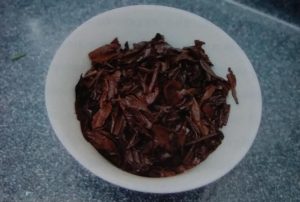
These-brewed-tea-leaves-are-from-a-dry-stored-tea-cake.-The-color-of-them-is-more-reddish-than-other-Puerh-of-the-same-age.-This-may-be-due-to-higher-temperature-during-storage.
Despite all the differences between regions, I am not suggesting one move for the sake of one's Puerh tea (though what a commitment that would be). However, if one is contemplating whether or not to establish a Puerh cellar, one should not disregard the risks involved in the place one chooses to live. Regional dangers are more difficult to avoid, but those caused from the variations of the districts within a given town or city could easily be solved by renting storage space elsewhere. It would be a tragedy to see a large quality of well-aged Puerh destroyed by a natural disaster or some kinds of improper storage. Apart from losing money, such a loss squanders the precious and invaluable tea itself. Money cannot buy back such quality and age. Eventually, one will be forced to buy others' time, purchasing well-aged Puerh from others at much higher prices.
First of all, one needs to consider the danger from any natural disaster in one's area over the course of say thirty to fifty years. For some places, this is not an issue while for others it can be serious. There are not many generalities. In most cases, though, I would not recommend setting up a Puerh cellar in a low-lying land, with an altitude below sea level. These areas usually have a higher risk of typhoons, hurricanes or even flooding. As a long-term investment, whether for personal or financial enjoyment, storing Puerh in such a place would increase the risk of loss greatly. If one is a Puerh tea lover living in an area with such risks, I would advise you to just keep several tea cakes for amateur purposes, rather than stockpiling large quantities at home. It will be better for those living in areas where the chance of natural disaster is high to enjoy Puerh tea by purchasing genuine, well-aged vintages from others. Though such cakes are expensive, they are entirely risk-free enjoyment.
If a tea lover insists on having their own Puerh cellar in a more dangerous area, like those below sea level, then I would recommend at least keeping one's Puerh in a concrete apartment situated at a higher elevation. In that way if there is a flooding, one's assets will avoid being destroyed. Although storing Puerh on higher floors, or even upstairs, is usually a good idea, it sometimes causes problems if an apartment is on the top floor of a building. This is because the temperature of the apartment can be very high during the summer. Keeping Puerh tea in an environment with such a high temperature will be the same as putting it in an oven. The tea may become sour and undrinkable. In fact, this violates the basic storing conditions of Puerh we discussed in Part 1; one of which was the temperature control. One should make sure that if one lives on the top floor, the temperature can be controlled to within a reasonable range, perhaps around 30 degrees Celsius during the hottest season.
Hopefully, everyone can recognize the importance of choosing a good location to store large quantities of Puerh tea. Whether one wishes to get a high return on a financial investment or merely to have a lot of great tea to drink in retirement, location is a key factor in avoiding the risks that could ruin one's dreams. This can't be overstated. It is, therefore, often better to avoid using a ground floor room or apartment to store one's Puerh tea, as the environment is usually not suitable, The danger of flooding is always there. However, even on upper floors, one's Puerh tea will still be contaminated if a flood happens downstairs because flood water is usually filled with germs and bacteria, causing a vast array of terrible and stagnant odors. After several days of flooding, this bad smell will definitely be absorbed by the Puerh upstairs. Consequently, choosing an area that will not ever be affected by flood water is very important.
Apart from flooding, there are other potential disasters one must be mindful of. Fire is also a threat. The tea being directly destroyed by fire is not the only issue either. Even if there is a fire around one's Puerh cellar, the smoky smell will quickly become a dangerous enemy. Also, if a Puerh cellar is located in or near a forest, one will have to be very careful of insect infestation, such as white ants. The conditions around tea cakes of aging Puerh are also often suitable for termite colonies. They will build their home in stacks of Puerh tea, especially when there is a larger quantity.
Choosing an area free from any natural disaster with a stable climate is the most important criteria for storing Puerh tea. Once the correct geographical location is chosen, where to keep ones' tea within one's house or apartment is the next issue one needs to regard.
Micro-view of Home Storage
In order to keep Puerh at home, which room is used for Puerh storage is an important concern. It is essential for collectors to know all the bearings of the rooms in their homes by using a compass. They should know where the sunlight comes in and if water may leak into the Puerh cellar during a rainstorm. As I have emphasized here so often, avoiding risks is more important than creating an ideal aging environment because an unpredictable catastrophe could ruin a Puerh collection and then the aspects of the environment that produce better vintages are all irrelevant anyway. I am here just stating general principles; one must consider the risks on a case by case basis. For example, in my home town, Hong Kong, I keep my Puerh tea in a room near the north of my apartment, as it is ideal in terms of light and temperature.

The bearings of an apartment affect the establishment of a Puerh cellar.
In looking at this illustration, one can see that mine is a classic-style apartment for Hong Kong, with its limited land and space. Firstly, one cannot store Puerh tea in the kitchen because the oil and other odors will infect it over the years. Besides, the temperature of the kitchen is usually higher than the other areas in one's house or apartment. It is not appropriate to store Puerh tea in the kitchen, even though it may be convenient for brewing. Secondly, it is also not good to keep Puerh in the bathroom, washroom or any room near to them. The reason is obviously that the bathroom and its environs are filled with moisture and odors. Dampness will often create an environment conducive to the growth of micro-organisms. Furthermore, if there is any water leakage, it will usually take place around these areas. Consequently, apart from the bedroom and sitting room, the rooms marked A, B and C in my home were the possible choices for a Puerh tea storeroom. However, not all of them are suitable.
In getting to know my home, I noticed that the room temperature of C will increase during the day, starting when the sun rises from the east in the morning (but each case is different and this may not apply to another collector if there is another building next door blocking the sunlight). In summer, this results in long-term exposure to high temperatures, which is not healthy for Puerh tea. As one can easily imagine, going into room C in the summer, without any air-conditioning, would make one feel sultry and uncomfortable. The situation would be even worse if there were windows in room C, allowing direct sunlight to shine onto the tea. If the only available room has that problem, one will need thick curtains to absorb the heat and block the sunlight. During the afternoon, when the sun is shining from the west, the temperature of the western rooms will go up, particularly from 2pm to 6pm. Sometimes, it is not easy to be fully aware of the storing conditions of a given room, like C, because we spend most of our time at the office rather than at home monitoring the ambient climate. One will have to find a way to record this information while one is away, or in his or her free time. In Part 1, I established that Puerh tea needs a range of temperature that is neither too high nor too low. This will be a key factor in deciding which room to be used.
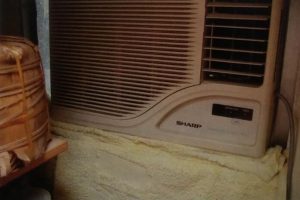
I always use a towel to fill the gap between the air-conditioner and the windowsill to prevent water from.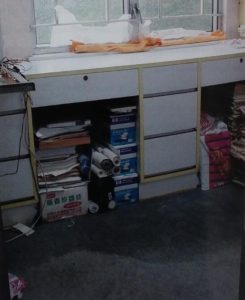
During a strong typhoon in 1999, water leaked through malfunctioning waterproof plastic seals. Fortunately, there was no Puerh tea stored in that room at that time.
By eliminating room C, I was left with rooms A or B for Puerh storage. I could not find any other obvious reasons to exclude one or the other at first, so both A and B seemed suitable for storing Puerh. However, after some thought, I realized that in Hong Kong there are often typhoons coming from the South China Sea. Consequently, because of the climate in Hong Kong, storing Puerh tea in room B could potentially be dangerous. If the windows were broken during a typhoon, my Puerh would all be drowned. And even if no window got broken, there could still be water leakage problems caused by the torrential winds. Drops could be forced into my apartment through the creases between the air-conditioner and the windowsill. (Incidentally, no matter what room one chooses, one can see that I always use a towel to fill the gap between the air-conditioner and the windowsill to protect my Puerh cellar.) In August 1999, Hong Kong was attacked by a strong typhoon and there was indeed water leakage in one of my rooms. Obviously, the carpet was soaked. Water leaked through the so-called "waterproof" plastic seals which were used to seal the gaps between the windows and their frames. Strong winds had forced the water into my room in fountains of pernicious and destructive pools. All the documents on the floor were destroyed. Fortunately, there was no Puerh tea in that room at the time. Still, the typhoon corroborated my earlier assumption that room B was not the better choice.
Though all these factors are important, the individual decisions that I made with regard to where I should store my Puerh tea are only relevant to my particular apartment. Every person will have to make similar decisions based on the layout of his or her house. After considering the factors of Puerh storage discussed in Part 1 - like humidity, temperature and odor - one must then also find the place in one's home with the minimal amount of risk, by reference to the geographical climate, bearings and any other unique aspects relative to one's location, as well as the layout of one's home.
Setting Up a Puerh Cellar
After choosing a good location to hoard Puerh for the coming 20 to 50 years, the next important step is to decide what kind of teas should be put on the top or at the bottom of your Puerh cellar. The Puerh one keeps at a higher level will get better ventilation. Furthermore, the higher one places the tea, the better protected it will be, free from water-leakage or any other potentially harmful odors or pollution. Even if I might have had Puerh in the room affected by the typhoon in 1999, as mentioned above, my tea may have still aged normally if I had placed the tea on a higher bookshelf rather than on the floor.
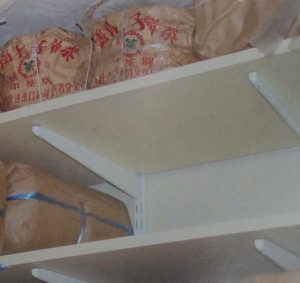
The second shelf down is the best place for keeping the most valuable and expensive teas.
Is the top shelf of the Puerh cellar really the best, though? Actually, this might not be the case. In fact, for me - giving in an apartment in Hong Kong - the second shelf down is the best place for keeping my most valuable and expensive Puerh. The reason for this is that even if my Puerh cellar is properly protected, my neighbor living upstairs may not keep his or her apartment in such good condition. If there were water leakage from the ceiling, I would be very sorry to see the most expensive part of my collection destroyed. Usually, most collectors would agree that the second or third shelves are the best for keeping one's most valuable tea cakes as they are protected from damage coming from above or below. Still, finding the best shelf within one's cellar will require some of the same deductive thinking that one used in deciding which room is ideal.
A Puerh cellar in closets, drawers or basements
If one learns about Puerh and the requirements for its aging, there really is no harm in keeping it in closets, drawers or other spaces because one will know how to correct any abnormal aspects of the environment. However, this really requires practical experience (and maybe even a few tears) to learn. Therefore, let us have a short discussion about storing Puerh in closets, drawers and basements.

Puerh should not be placed next to a transformer.
Storing Puerh in closets and drawers usually follows similar guidelines because they occupy a similar part of one's room. First of all, one should be concerned about the odors from the closets or drawers when they are new or when they had stored something else previously. One should make sure that the closets or drawers are completely odor free. Some woods used in the construction of shelving units or drawers have been painted or stained, and have a distinct odor even when new. Of course, anything else that was stored in them would also have left its odor behind. The collector will have to find a way to air them out and remove any bad smell or odor. Another problem with closets and drawers is ventilation. Unless one has a habit of opening the closets or drawers regularly, the fresh air inside them may not be enough. If a strange odor gets trapped inside, the Puerh will definitely be ruined. One will have to make sure that the closets or drawers are opened with enough consistency to allow the tea to breathe.
In order to save on storage space, some tea collectors will simply toss their Puerh tea on the top shelf of a closet. This is okay, as long as the closet does not have a quartz lamp installed. Otherwise, when the quartz lamp is switched on, it will generate heat, which is not healthy for one's Puerh. In addition, one should also be careful if there is a transformer installed at the top of the closet. Transformers also emit heat, and without enough room can even be a fire hazard. Apart from these caveats, storing Puerh tea in these areas will prevent exposure to daylight, and are therefore usually decent places to keep tea.
If the space in one's apartment or house is limited, or perhaps if one just has a small Puerh tea collection, my suggestion would be to pack the tea up in a clean cardboard carton before placing it in such a closet or drawers. The carton will shield the tea from odors. It also preserves the teas' natural aromas that they release as they age. Also, be sure to check on the tea throughout its long voyage. This allows one to correct any disturbances that begin to develop, as well as providing ventilation as mentioned above.
Basements
Most Puerh collectors will not set up their cellars in basements unless they have substantial knowledge and experience storing Puerh tea. The most uncontrollable part of one's home is the basement; they are at risk with regard to humidity and ventilation. Also, if there is a flood, your basement will be filled with contaminated water and floating Puerh tea cakes. Besides that, owing to the location of a basement, it usually is too damp (Once again, depending on which geographical area one lives in. Some basement can be very dry.). Unless one really knows how to strictly control the humidity of the basement, the moisture accumulated there will most likely ruin a collection. A damp environment with no sunlight provides a very good home for mold, fungus and/or bacteria to grow. If one discovers that the basement already has specks of mold or mildew, take it as an indication that the basement is not suitable for storing Puerh tea.
The condition of a basement can be improved by installing a ventilation system. However, one needs to be sure that it will always work. Otherwise, the still air will be stuffy and sultry, which is not healthy for the tea. In such cases, one may wish to have a generator in case of power outages.
The Materials Used in the Construction of a Puerh Cellar
Besides the dehumidifier I mentioned in Part 1, it is important to consider what other materials one plans on using in the construction of one's Puerh cellar. If one is using wallpaper, for example, one must be extremely careful that the wallpaper is a variety which will remain free from condensation and/or mold. Also, the glue used to put it up should be resistant and, more importantly, odor free. If one chooses paint instead, again it should be waterproof and odor-free. In most cases, there is a strong smell after painting, soon one should not move the tea into the room until all traces of this smell have gone away. I would also not recommend using ceramic tiles to decorate the walls of a Puerh cellar, as these kinds of material easily result in condensation during the spring and summer.
Having learned from my own experience of improper storage (discussed in detail below), I now know that it is important to leave enough room around the tea cakes so that they receive proper ventilation. The tea cakes should not touch the wall, but have some spaces in between (say at least one inch). There are two advantages to stacking Puerh in this way. First off, it is good for ventilation. Secondly, even if there is unexpected condensation, the tea cakes will not be affected as badly (in fact, a good ventilation path can even correct condensation). Since my Puerh cellar is dry, clean and decorated with waterproof wallpaper, leaving a half-inch 'ventilation aisle' is reasonable enough.
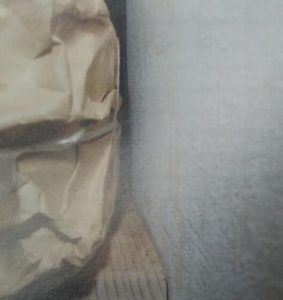
I used waterproof and mold preventative wallpaper. Since my Puerh cellar is dry, clean and decorated with waterproof wallpaper, leaving a half-inch 'ventilation aisle' is reasonable enough.
As with the walls, paying attention to the materials used in the construction of the shelves is also important. It is advisable to use a stainless steel bookshelf. Such racks occupy less room and allow more Puerh tea of different sizes because the rack itself is adjustable. The ventilation of these kinds of shelves is also good because it is not a solid flat board, and air is allowed to pass through the bottom. And since it is made of stainless steel, there will be no rusting in the future. Moreover, many kinds of wood, or the paint/stain used to decorate them, have distinct odors that will affect the Puerh over time. I, personally, do not want a woody flavor in my aged tea.
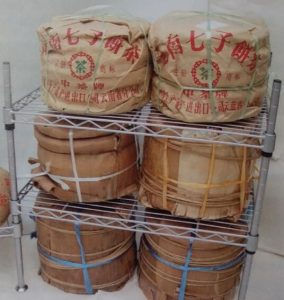
It is advisable to use a stainless steel bookshelf to keep one's Puerh. The ventilation is good because it does not use solid, flat boards.
If one does not have a whole storeroom and is instead using normal bookshelves, a closet or drawers as a Puerh cellar, please make sure that the materials are waterproof and free from condensation and odor. One must be careful with some smooth surfaces.
Storage Containers
For beginners, it is often not practical to set aside a storeroom especially for Puerh. Therefore, large pots are often the ideal alternatives. One may use porcelain, clay or even stainless steel to store one's Puerh. The most important point, which I keep repeating with regard to all the materials used in Puerh storage, is that the pots must be odor-free. Also, if the container is not dry enough, the moisture will get trapped inside and the Puerh will get wet. So one should make sure that the container is completely dry before transferring the tea.
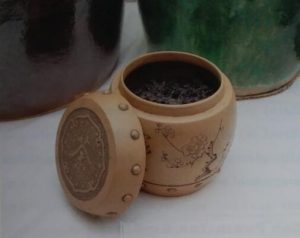
A small, purple-clay tea container is very suitable for storing Puerh for daily use because it is gorgeous and helps the aging process.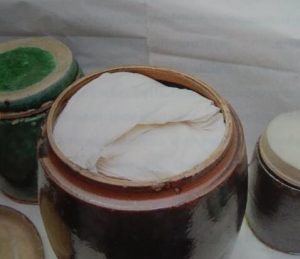
Large pottery is also good for storing Puerh, especially aged vintages.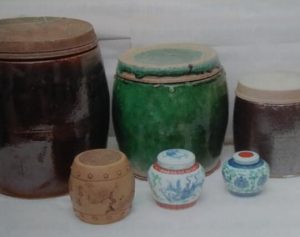
Different sized containers made of different materials can help different kinds of Puerh.
Plastic Bags
Generally speaking, storing Puerh in a plastic bag will result in a plastic odor transferring to the tea. From my personal experience, the negative effects of a plastic smell really depend on the bag. I have seen okay plastic bags, as well as those that will ruin tea. As long as the plastic bag is manufactured for food storage, it will usually be okay for tea also. I would recommend being careful about this, though. Also, one must bear in mind that plastic bags prevent any ventilation. Consequently, whenever there is any water absorbed in the tea cake, it will definitely get trapped inside the plastic bag when it evaporates. In other words, Puerh stored in plastic bags must be very dry when it goes into the bag. For that reason, I would not advise storing newly-made Puerh in plastic bags because it has more moisture and needs more ventilation. I only put my well-aged (20 years or above) Puerh tea cakes into plastic bags. It is not necessary for them to ferment quickly anymore. Plastic bags will help preserve their aromas and tastes. Sinee plastic bags are ventilation-proof, odors cannot contaminate the aged Puerh inside, and the tea's flavor are kept sealed within. Sometimes, these plastic bags are full of the aroma of aged tea after just months of storage. Consequently,
I recycle these bags for aged tea of similar flavors - improving the aroma of the second tea greatly. Furthermore, it is worth emphasizing that some well-aged Puerh vintages such as the Red Mark must be sealed. As these aged Puerh teas have already reached their pinnacle, the wonderful flavors and aromas might just be lost if we allow them to come in contact with too much air. Preserving antique and masterpiece Puerh vintages in plastic bags is practically essential.
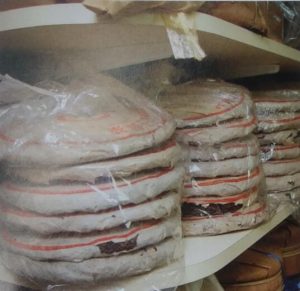
Plastic bags for food storage are often suitable for storing aged Puerh as they can preserve the aged aroma and taste. However, the water content must be low enough.
Blue Mark Grade A: Masterpiece Puerh vintages should be preserved in clear, odor-free wrappers in order to keep their aged aroma in.
I personally do not agree with shrink-wrapping Puerh because in the process of making the plastic shrink, heat is necessary. If the heat applied to the tea cake lasts too long, the quality may be affected. However, if one really wanted to use this method, he or she would have to be very careful in choosing the shrink wrap because some are designed for shrink-wrapping food while others are not. Like plastic bags, choosing the wrong shrink wrap could be catastrophic.
Can Puerh Tea Be Stored Casually?
It is said that Puerh tea can be stored casually. Is this correct? To a certain extent, it is true provided the collector is very familiar with how to store Puerh tea. Sometimes, I joke with friends that I just put aside my Puerh tea collection "casually". In fact, no matter where I put my tea, it is still inside my cellar, which provides it a very stable and optimum aging environment. Therefore, putting Puerh away "casually" really implies all the work I did to make my cellar. As I have emphasized many times, the most important skill in storing Puerh is not to quicken its aging process, but to protect it from danger throughout the aging years. It is actually worthwhile to learn more about humidity control in different seasons wherever one lives. I hope my experience can help other collectors reach the point where they too can put their tea away "casually".
Ventilation - The Pros and Cons
Beginners usually prefer to buy newly-made Puerh tea cakes. They often feel the well-aged teas are not worth the exorbitant prices, and would rather spend money on newborn tea cakes. In order to speed up the aging process, they toss their collections into highly-ventilated areas. According to my personal experience storing Puerh tea these 10 years, I find that "adequate" air flow is good for aging, but not "over-ventilation". If there is too much fresh air, the Puerh tea cakes (or loose-leaf Puerh for that matter), as I mentioned in Part 1, will have very weak flavors, sensatious and aromas. This happens because the fermentation process occurs too fast.
Ventilation can also cause problems because it risks allowing excessive damp air to flow into the Puerh cellar - perhaps without even being noticed, especially when you misjudge the humidity on any given day. Of course, no Puerh cellar is complete without a hygrometer, but a hygrometer cannot tell you on which day you should open your window(s) to increase the fresh air and on which day you should shut your window(s) tightly and switch on the dehumidifier. One needs experience to judge that. As I mentioned in Part 1, I find that the optimum range of humidity is around 70% to 80%. This does not mean that 85% is hazardous to Puerh. Sometimes, exposing Puerh to a relative humidity of 85% may help further its fermentation career, but exposure to that higher humidity should not be far too long.
Even though Puerh tea needs to adsorb enough water for aging, the water should not stay too long in the tea cake. That is why one must have a dehumidifier to correct the environment after an increase in humidity. For beginners, I would suggest only opening windows during clear days in the fall. On stuffy and rainy days, one should never try to ventilate the tea. Actually, on the contrary, one must try to lower the humidity on rainy days. If one is confused by all this, I would suggest that one simply keep his or her window(s) closed completely during the spring and summer, only opening them briefly in the fall. The only real drawback of aging tea in this way is that it may take a bit longer to ferment. Still, safe is better than sorry.
Most well-aged Puerh vintages come from the tea warehouses; that used to be so predominant in Hong Kong. At that time, tea vendors did not intentionally let fresh air in, but those tea cakes have still become masterpieces. However, in order to make the tea cakes have even aging conditions, tea vendors at that time did rotate the tea from top to bottom. I believe that this definitely improved the overall aging condition of the warehouse. Therefore, from my point of view, rotating the position of Puerh is more important then ventilation.
Rotation Over Time - Is it necessary?
The major difference between Puerh tea stored by private tea collectors and that stored by tea vendors is amount. Large tea vendors have huge tea warehouses which are storing several hundreds to thousands of baskets or boxes (traditionally, 84 tea cakes per basket or box). Since the amount of Puerh is enormous and the Puerh will not be sold immediately, it may have to stay in the warehouses for the coming 5 to 10 years. After that amount of time, the taste of the Puerh stored on the top and at the bottom of the pile would certainly be different because of the differences in ventilation. Therefore, conscientious Puerh tea vendors will hire workers to rotate the positions of the tea in order to assist the aging process. Since this is a huge project, Puerh tea vendors usually make rotations every 2 to 3 years depending on the warehouse.
For private tea collectors, since their collections are not as large as tea vendors, it is not necessary to rotate the tea so frequently. I would advise private tea collectors to move their tea collections at least every 5 years. One advantage of tea rotation is that it allows one to check the storage conditions of the tea. In a period of 20 years, 4 rotations are not that inconvenient if they can really help the aging of one's cakes. These rotations should be performed in the fall because the humidity and temperature are more moderate. Make sure that the dampness of the tea cakes is low enough for repacking. Otherwise, one will make the same fatal mistake made by a friend of mine, as we discussed in Part I, in which the water absorbed from the air was trapped inside the cake when it was repacked.
Puerh Tea in the Office
In Hong Kong, owing to the limited quantity of land, people have very little space to live. It may be the same in other large cities around the world. When such collectors buy a large quantity of Puerh and it is finally delivered to their homes, they may realize that there is actually not enough space in their already bulging storeroom. In order to find more space to store Puerh, aficionados in Hong Kong will store some or all of their Puerh collections in their offices. Also, sometimes other family members may be opposed to the Puerh piling up at home, especially if they are stored in a messy way.
A friend of mine is very serious about Puerh tea. Before even asking his boss, he filled up half of his office with Puerh. In fact, the place looked more like a warehouse than an office. Not only had the bookshelves become Puerh tea shelves, some Puerh was being stored in large clay pots underneath the shelves and every table he had in the room. My friend was satisfied with the storing conditions of his office as he was of the view that the office had constant air-conditioning and a stable temperature and humidity. However^fthi^ idea was based on some misconceptions. I told him that:
1. The ventilated air in most offices, including his, is centralized and not nearly as fresh as the air outside the building. Actually, artificially altered environments will never, ever create the best vintages of Puerh.
2. If the air-conditioning was not really functioning 24 hours a day, as he suspected, then the temperature would fluctuate during the night. This would create drastic changes in temperature, especially in the summer, that would not be healthy for his tea.
3. Even if there never was a fire, if something went wrong with the sprinkler system installed in the building, the Puerh tea would all get wet. Even though the possibility of this happening was low, it was still a risk.
4. It was not possible for my friend to know the humidity during the night time.
In his office, I saw a bare tea cake being displayed for a certain period of time on his Puerh shelf. I noticed that the surface of the tea cake was red and dull, which was not like the examples of this same tea cake that I had, which were properly stored. I believe it was caused by long-term temperature and humidity fluctuations.
Of course, there is always a solution: If one really wants or needs to store Puerh in the office, the first thing to do is to get a big and thick cardboard box and put different kinds of Puerh in different smaller cartons within the larger box. The thick cardboard box will help provide a stable storage environment for the tea. When the temperature outside the cardboard fluctuates, synchronization takes time. This reduces the chance that changes in temperature and/or humidity will greatly affect the Puerh. Cardboard boxes are actually the most useful tool for Puerh storage anywhere. The rationale behind using smaller cartons within the larger one is so that there is a separation between the distinct odors of each tea, and no cross-contamination.
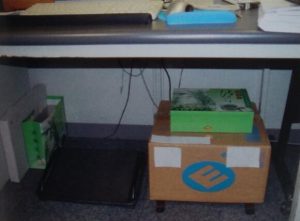
You have to raise the carton so as to avoid direct.
Puerh has to stay away from the cool air blowing.
The collector will then have to decide where in the office to keep the large cardboard box. I would suggest putting it under one's desk rather than on top of the bookshelf because it should be kept away from the cool air blowing out of the air-conditioning ducts in the ceiling. However, even if one keeps the box under his or her desk, one should not just put it on the floor. It would be a good idea to use plastic or any other materials found in the office (for example, packs of A4 paper) to place under the box. The purpose of doing this is to avoid direct contact between the box and the ground. If the office is fitted with carpet, there may be all kinds of pipes, wires and/or ducts running underneath the floor plates. Even if the floor is concrete or tiled, water could condense on the surface if the difference in temperature ever grows large enough, and one would not even notice because this usually happens at dawn. To prevent these or any other such disasters, I would recommend storing the large box off the floor somehow.
More Experience of Improper Storage
Once one has come to understand most of the necessary conditions for the storage of Puerh, discussed in Part 1, as well as a more detailed understanding of risk prevention and storage location, then it becomes much easier to store large quantities of Puerh tea with success. However, this is not to say that there will not be problems along the way. No matter how much knowledge one has, there still may be difficulties over the course of so many years. It helps to learn from the experience of others who have stored tea for some time; to read of their mistakes with the hope that we need not repeat them ourselves. Here is some of my experience with regard to improper storage:
At the end of Part I, I briefly mentioned that I had accidentally created some so-called "wet storage" tea at home. However, strictly speaking, the tea's condition was better classified as "improperly stored" rather then "wet storage". "Wet storage" tea is often done consciously and with great skill. It can result in delicious or disgusting tea depending on if the storage was done properly and for how long. It is a genre of tea like any other, with its own range of kind, as well as spectrum of quality. When a tea is "wet" because of improper or mistaken storage, it may perhaps more aptly be called "improperly stored" in order to distinguish it from the former genre of tea. After that mini-storage disaster, I learned how to store tea more properly in a dry and stable environment.

Illustration: Practical experience of improper storage.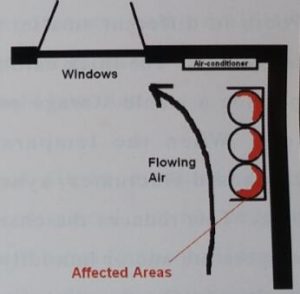
Floor plan: Practical experience of improper storage.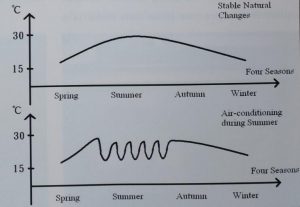
If you turn on the air-conditioner in summer, the surrounding temperature of the tea cakes will fluctuate like this.
It happened in 2001. I had just bought some newly made tea cakes and I hoped that they could be appreciated as soon as possible (in essence, I was impatient). I removed the bamboo bark wrapping from several stacks. Then, I placed them on a bookshelf in the sitting room in order to maximize the ventilation (you may refer to the illustration). Coincidentally, the bookshelf was very close to the air-conditioner. My intention was not to allow my Puerh to enjoy the cool air, but just to get maximum ventilation. As you can see from the floor plan and the illustration, there were also windows right next to the air-conditioner. When the air-conditioner was not switched on, the breeze from the window would provide enough fresh air for my Puerh to age quicker (or so I thought). Perhaps if the air-conditioner was never used, that location would have been a nice place to store Puerh tea. Unfortunately, the tea cakes joined the ranks of the "improperly stored" in just one summer.

Photo taken in 2004, three years after the improper storage. Those 3 tea cakes in the second row were the affected tea cakes, while the upper 3 tea cakes had always been properly stored. You can see that the tea cakes in the second row were still not shinny and the taste was not as fresh as the upper ones. However, the bitterness of the affected tea cakes reduced faster.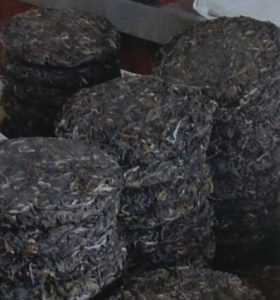
Photo taken in 2001 after improper storage. You can see that the tea cakes in the top left hand corner were less affected, so they were still shiny. The others had different degrees of damage. White stuff appears on the surface of the tea cakes depending on the location.
One day, I went to the bookshelf to get a book. I suddenly smelled a rather unpleasant odor coming from the first row of Puerh I had there. The smell was a bit similar to those tea cakes that have gone through too much "wet storage". At that moment, I was wondering why such an unpleasant smell was coming from my tea, because I was sure that the tea cakes were very dry and beautiful when I had bought them. Naturally, I opened the paper wrapping to see what had happened. "Oh, no!" I was astonished as I removed the paper, for I soon realized that even the tissue wrapping paper was soft and slightly damp. Then, I could see some white stuff on the surface of the tea cakes. I thought I was facing a disaster of epic proportions. I was lucky, though. Fortunately, when I broke up one of them, I found that the inside was not seriously affected. It seemed that the improper storage had only just begun and I had caught it in time.
As I examined the tea cakes more carefully, I noticed that the white stuff appeared only on one side of the tea cakes - the one nearest to the back board of the bookshelf (You may refer to the floor plan. I marked those affected areas in red). The other side, which was properly ventilated, was not affected. After a careful study of the storage location, I discovered that the reason for this improper storage was the huge fluctuation in temperature that occurred over the summer whenever the air-conditioner was switched on (you may refer to the temperature chart). The sudden changes in temperature had caused water molecules in the humid air to condense on the cool and smooth surface of the bookshelf. The tea cakes were consequently getting damp on and off every day. One might think of this as analogous to one's glasses getting misted after coming in from the cold. Such condensation is a natural phenomenon. Since the tea cakes were situated in a cool environment for a certain period of time, mostly because I had placed them so close to the air-conditioner, the tea itself would drop in temperature. Of course, I did not then wait until the temperature of the tea cakes reached more or less room temperature before opening the windows. Actually, I found out later that the synchronization of temperature took very long time because the ventilation at the back of the bookshelf was poorer than the front. Therefore, condensation would certainly occur when the window was opened even though I might have waited for half a day.
Owing to the proper ventilation at the front of the bookshelf, it would have been difficult for me to notice the condensation at the back.
I would have had to lift up the tea cakes and check each one individually. Once the condensation had taken place, though, it was not easy for the water to evaporate because of the poor ventilation at the back of the bookshelf. After one or two months, this resulted in the peculiar odor I had noticed that day.
As I mentioned, I had removed the bamboo bark wrapping materials from the stacks in order to maximize ventilation. Would the situation have been different had I not done that? I do not think it would have made much of a difference Having the protection of the bamboo bark would certainly have reduced the damage, but not stopped it. The back of the bookshelf was that wet. And the moral of this story, that I learned the hard way, was that placing one's tea cakes near to an air-conditioner is not healthy at all unless that air-conditioner is just a decoration.
In recent years, after grouping my collection into my Puerh cellar, I have not had any similar situations occur. Although I do have an air-conditioner installed in my Puerh cellar, I only turn it on at the rarest of occasions for a short time, and I will regularly check on those Puerh next to it after such an occasion. I also pay much more attention to the materials used in the construction of my Puerh cellar. As mentioned above, smooth surfaces like those used in wooden bookshelves are not ideal. Learning from experience is often the way lessons stay with us, lasting in our memories more poignantly when it is our tea that smells funny.
The Recovery of Dry-stored Puerh The storage conditions I adopted for my collection are 'dry with low ventilation'. The reason why I am doing this is to slow down the fermentation of my tea. While some people are trying their best to quicken the aging process, I am taking the contrary approach because of my young age. I do not want my collection to be fully fermented at the same time (say 20 years from now), but rather to come to fruition at various times in my later life. I already have enough aged Puerh to appreciate in the meantime, and I can therefore wait 20 years for a new Puerh to mature.
However, there is a drawback to using such a storage method. Since the humidity has been low for quite a long time, brewing tea from such a collection would result in tea that is dull with a dry aftertaste. One would feel uncomfortable after drinking Puerh stored in this environment. Can this be corrected? Yes, I simply put these kinds of dry-stored tea cakes out in normal humidity with adequate ventilation for some time. After several weeks of contacting normal fresh air, the Puerh will be smoother and sweeter. The dry feeling in the aftertaste will also be reduced and the tea will become gorgeous. We usually call this process "Revivification" which means to "re-vivify" the tea, making its flavor smoother and more pronounced - more vivid.
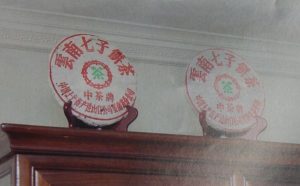
Displaying intact tea cakes on your tea shelf to recover the Puerh is also a good way, although it will take longer time.
This method takes several weeks or, sometimes, months (the longer it was stored in a dry condition, the longer of a recovery it needs). When I discover that a certain kind of Puerh tea is only filling its container halfway, I will take out an intact tea cake from the cellar and break it up entirely and then set it aside for "Revivification" within its original paper wrapper. I will then give it several months to "re-vivify" before drinking it again. Displaying an intact tea cake on your tea shelf can serve the same purpose. However, without breaking the entire tea cake, it will take longer to "re-vivify" (half a year maybe).
The Minimum Storage Period
After reading so much information, you may wonder how long one needs to wait for the harvest. The flavor of raw Puerh tea cakes are changing every year. In fact, newly-made tea cakes are not undrinkable. They are just not as tasty, as smooth or rich, as the well-aged vintages. If one enjoys the green taste of newborn Puerh, there is no reason why one should wait. Enjoy the tea now. However, from most connoisseurs' point of view, the most fascinating aspect of Puerh is the rich and smooth broth offered by a marvelously aged tea cake - a peaceful bliss, comfortable feeling and sweet aftertaste which lasts for quite a long time. Therefore, the term "drinkable" in the connoisseurs' eyes often means that the tea cake has reached its maturity.
I first started storing tea in 1993, and my first stack of tea cakes was the Zhongcha Brand Traditional Chinese Characters Seven-son Tea Cake ("Traditional Character"). It is now 14 years of age. It already offers me a pleasant and soft, slightly green, honey taste. However, the bitter astringency is still there, though not as bitter as in its first 5 years. Following this trend, I expect that my Traditional Character tea cakes will be very tasty when they reach 20 years of age. Still, I would not advise drinking a lot of these immature raw tea cakes because they are too green to appreciate. It is nice to taste the changes, but better not to waste too much of these 1990's vintages, saving them for the time when they are truly mature.
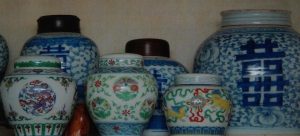
Porcelain allows poor ventilation and therefore it is suitable only for storing weH-age.d Puerh. It is good for preserving the aged taste.
In the meantime, while storing raw Puerh, one will need some ripe Puerh, wet-stored Puerh, or even some well-aged tea if one can afford it. Self-stored Puerh is mostly for future consumption. If one does not appreciate the green taste of newborn tea, saving them and finding some of these alternatives is better. Although I have a lot of newly-made raw Puerh tea cakes, I seldom brew them unless I want to trace their aging process. My daily Puerh favorites are 1970's Zhongcha Brand Simplified Chinese Characters Seven-son Tea Cakes, 1970's Yellow Marks and 1980's 8582 Seven-son Tea Cakes. In short, Puerh tea cakes should be appreciated at their appropriate ages.
I hope that my experience storing Puerh tea at home will be of some benefits to others who also wish to start storing tea. There is great joy in this hobby, and an even greater reward years down the road when it comes time to harvest one's delicious aged tea. Using the guidelines discussed here and in Part 1 will help prepare one to face the challenges that decades of storage will surely present. There is no way to cover all the possible problems that one will face, but learning from experience will be better anyway. Every real collector has paid a tuition somewhere along the way. Despite my own losses, I still feel that storing Puerh tea is a very rewarding hobby. Through Puerh I have made great friends and many lasting memories. Hopefully, other readers will also find such treasure in the world of Puerh tea.



